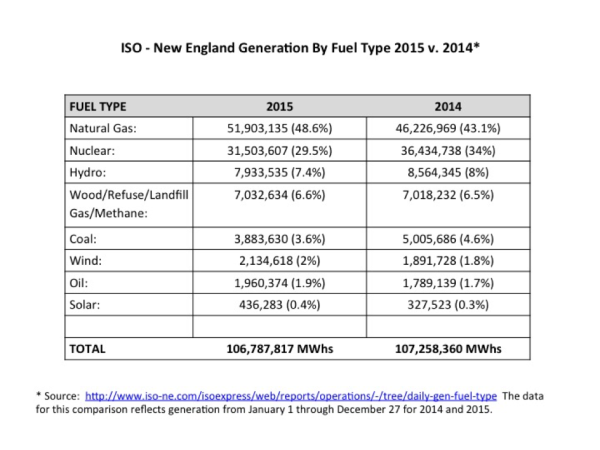The Vermont Yankee nuclear power plant ended its operations at the end of 2014. Elected officials and environmentalists claimed that its generation would be replaced by “carbon-free” solar and wind power. However, that did not happen. New England upped its natural gas generation to make up for the lost power from Vermont Yankee, as data from the Independent System Operator for New England shows.[i]
In 2015, natural gas supplied 48.6 percent of New England’s electricity demand, while in 2014, it supplied 43.1 percent. In other words, natural gas supplied 5.5 percent more of New England’s electrical demand after Vermont Yankee was closed, while nuclear power supplied 4.5 percent less. Nuclear generation in New England dropped from 34 percent of the region’s electrical demand in 2014 to 29.5 percent in 2015. The other major change in fossil fuel generation was a decrease in coal generation’s share from 4.6 percent to 3.6 percent of electricity demand.
These changes occurred while electricity demand in New England remained approximately flat. Generators in New England produced 106.79 million megawatt hours in 2015—0.4 percent less than the 107.26 million megawatt hours they produced in 2014. Wind and solar combined represented a 2.1 percent share in 2014, which was increased to 2.4 percent in 2015. The increase helped to alleviate the gap caused by hydroelectric power reducing its share from 8 percent in 2014 to 7.4 percent in 2015. (See table below.)
Source: http://yesvy.blogspot.com/2016/01/the-replacement-for-vermont-yankee.html?spref=tw#.VpVVq_krLIX
Carbon Dioxide Emissions Increased in New England with the Loss of Vermont Yankee
Nuclear power generated about 5 million megawatt hours less power in New England in 2015 than in 2014, while natural gas generated almost 5.7 million megawatt hours more. Note also that coal-fired generation produced 1.1 million megawatt hours less electricity in New England in 2015. According to the U.S. Energy Information Administration (EIA), natural gas-fired generators produce 1.21 pounds of carbon dioxide per kilowatt hour and sub-bituminous coal produces 2.15 pounds of carbon dioxide per kilowatt hour).[ii] Using that information, the additional electricity generated from natural gas-fired units in New England in 2015 equals over 3 million metric tons of additional carbon dioxide. However, some of those emissions are offset by the 1 million metric tons of fewer carbon dioxide emissions coming from coal-fired generators. Thus, without Vermont Yankee, New England generators emitted over 2 million metric tons of additional carbon dioxide in 2015.
Vermont Yankee’s Contribution to New England
Vermont Yankee, a 604-megawatt nuclear power plant, provided 42 years of reliable, carbon dioxide-free electricity to New England’s electric consumers. Over its lifetime, Vermont Yankee produced over 171 billion kilowatt-hours of electricity, providing 72 percent of the electricity generated in Vermont and 35 percent of the electricity consumed in the state. The plant’s capacity factor exceeded 80 percent over its lifetime – more than double the capacity factor of the most efficient solar or wind plant in the United States. The plant’s final operating cycle, which ended on December 29, 2014, was the culmination of 633 days and nights of continuous operation.[iii]
Vermont Yankee’s Demise
Vermont Yankee is an independent power producer (merchant plant), and as such, the costs associated with its operation and maintenance cannot be recovered through regulated cost-of-service rates. Vermont Yankee’s owner, Entergy, announced in August of 2013 that it would be closing the plant at the end of 2014 due to financial factors that included low wholesale electricity prices reducing the profitability of the plant; the need to invest in significant capital costs to maintain the unit based on NRC’s requirements; and low prices in the regional market for electric generating capacity, which provides revenue to plant owners in addition to their revenues from electricity sales. Low natural gas prices have resulted in low wholesale electricity prices, and have made natural gas the major supplier of electricity in New England.[iv] So, in this context, it is not at all surprising that natural gas substituted for the reduced nuclear power generation from the closure of Vermont Yankee.
New England’s Growing Dependence on Natural Gas
New England significantly increased its reliance on natural gas as a fuel for electric generation in the past several years. Natural gas provided less than 30 percent of the electricity generated in New England in 2001. But a decade later, the region’s reliance on natural gas generation increased to 52 percent, according to the Energy Information Administration. Unfortunately, transmission pipeline capacity has not kept up with the increased use for natural gas in New England. The lack of sufficient pipeline capacity is more pronounced in winter months, when natural gas is also used to heat homes and businesses. These infrastructure constraints have contributed to the large price spikes in spot natural gas and electricity prices in New England during several cold winters.
Conclusion
The closing of Vermont Yankee resulted in additional natural gas consumption as many analysts predicted, and with additional carbon dioxide emissions. Interestingly, Vermont was the first state to ban the practice of hydraulic fracturing, which produces the natural gas that is increasingly used in electrical generation. The shale gas renaissance has produced sustained low natural gas prices and low wholesale energy prices, resulting in financial problems for merchant power plants that cannot get adequate compensation to stay in business, especially due to subsidies and mandates for competing intermittent sources like wind and solar. Prudent management, however, means that diversity of supply issues should be considered. Relying on one major power source without adequate infrastructure could result in less reliable electricity generation and spiking of electricity prices.
[i] Yes Vermont Yankee, The Replacement Power for Vermont Yankee…Was Natural Gas, January 7, 2016, http://yesvy.blogspot.com/2016/01/the-replacement-for-vermont-yankee.html?spref=tw#.VpftF7nSnIX
[ii] Energy Information Administration, How much carbon dioxide is produced per kilowatt hour when generating electricity with fossil fuels?, https://www.eia.gov/tools/faqs/faq.cfm?id=74&t=11
[iii] Brattleboro Reformer, Vermont Yankee nuclear power station completes final operating cycle, December 29, 2014, http://www.reformer.com/localnews/ci_27220932/vermont-yankee-nuclear-power-station-completes-final-operating
[iv] Energy Information Administration, Vermont Yankee nuclear plant closure in 2014 will challenge New England energy markets, September 6, 2013, http://www.eia.gov/todayinenergy/detail.cfm?id=12851




